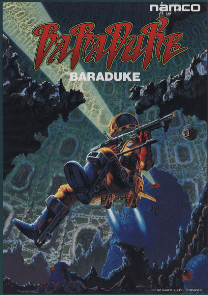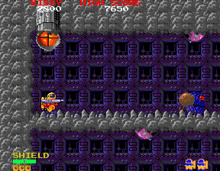Baraduke
Baraduke[lower-alpha 1], also known as Alien Sector, is a scrolling shooter arcade game originally released by Namco in 1985.
| Baraduke | |
|---|---|
 Arcade flyer | |
| Developer(s) | Namco |
| Publisher(s) | Namco |
| Series | Baraduke |
| Platform(s) | Arcade, Sharp X68000 |
| Release | |
| Genre(s) | Scrolling shooter |
| Mode(s) | Single-player, multiplayer |
| Cabinet | Upright, tabletop |
| Arcade system | Namco Pac-Land |
| CPU | Motorola 6809 |
Gameplay

The player takes control of a spacewoman in a biohazard suit, Player 1 is Kissy and Player 2 is Takky. They must clear eight worlds of increasing difficulty (each one is composed of five regular floors and one boss floor) by using their wave guns to destroy all the enemies populating them. They must also save the one-eyed Paccets for extra points and the chance to earn another shield in the end-of-floor bonus games.
On each floor there are a certain number of enemies known as Octy, which will leave power-up capsules behind when defeated. Defeating all the Octy on the current floor will open up a pipe at the bottom of the floor, and the player will have to find and enter it in order to proceed to the next one. The boss floors feature a giant enemy (a Blue Worm in Worlds 1, 3, 5 and 7, a Turning Eye in Worlds 2, 4 and 6, and the Octy King himself in World 8) who must be killed in order to proceed to the next world.
Release
Baraduke runs on Namco Pac-Land hardware, but with a video system like that used in Metro-Cross and Dragon Buster (modified to support vertical scrolling and a 2048-color palette). In 1995, ten years after its original arcade release, it was ported to the Sharp X68000, and was also included in the fifth volume of the Namco Museum series on the PlayStation.
Reception
In Japan, Game Machine listed Baraduke on their September 1, 1985 issue as being the fifteenth most-successful table arcade unit of the year.[1]
Legacy
A sequel titled Bakutotsu Kijūtei was released in 1988, but only in Japan. It was the second game from the company to allow scores not ending in "0" (the first was Hopping Mappy, which was released in 1986).
Although the game's primary protagonist, Toby "Kissy" Masuyo, is a woman, the player is led to believe she is a man until her face is revealed in the ending. This predated by one year Samus Aran from Metroid as a human female playable character.[2]
In the Mr. Driller series of games, Kissy Masuyo is a supporting character under the name Toby Masuyo (they refer to "Kissy" as being her nickname). She has married and divorced Taizo Hori (better known as Dig Dug, the protagonist of the 1982 arcade game of the same name) and they have three children, Susumu Hori (who is the main character of Mr. Driller), Ataru Hori, and Taiyo Toby. Kissy is also a playable character in the Japan-only tactical role-playing video game Namco x Capcom, where she is teamed up with Hiromi Tengenji from Burning Force. Because of her divorce, she seems to have a grudge against Taizo Hori, who too appears in this game (a reference to the Mr. Driller series). Tron Bonne, from Capcom's Mega Man Legends game, mistakes her for a boy.
A Paccet (which is a small, round yellow alien with only one eye) appears in the background as a painting in Tales of Destiny. Elle Mel Marta's backpack in Tales of Xillia 2 is also a Paccet, with a small charm shaped like Kissy attached to it. Paccet makes a cameo in Super Smash Bros. for Nintendo 3DS and Wii U as part of Pac-Man's Taunt, "Namco Roulette".
Notes
References
- "Game Machine's Best Hit Games 25 - テーブル型TVゲーム機 (Table Videos)". Game Machine (in Japanese). No. 267. Amusement Press, Inc. 1 September 1985. p. 25.
- "Hardcore Gaming 101: Baraduke". hg101.kontek.net. Retrieved 2018-03-01.